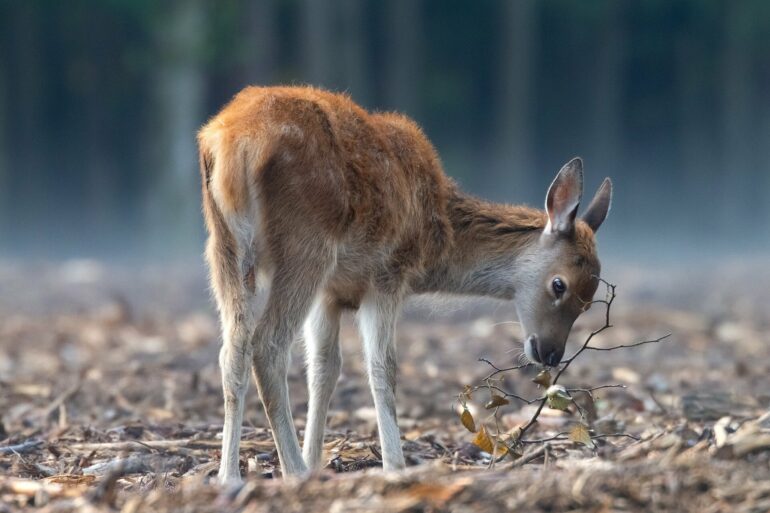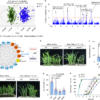Red deer may become less sociable as they grow old to reduce the risk of picking up diseases, while older house sparrows seem to have fewer social interactions as their peers die off, according to new research showing that humans are not the only animals to change their social behavior as they age.
A collection of 16 studies, including six from the University of Leeds, have been published today as part of a special issue of the Philosophical Transactions of the Royal Society B, investigating aging and society across the natural world.
One study into red deer shows that as older female deer become less and less social with age, they are cutting down on competition and reducing their risk of parasite infection. The study used data from a long-running project tracking a wild herd on the Scottish island of Rum.
Dr. Josh Firth from the University of Leeds’s School of Biology, an editor of the Special Issue, said that while previous research has often considered the process of becoming less social with age, known as “social aging,” as potentially negative, these studies show changing habits could in fact bring benefits.
Dr. Firth said, “These kinds of effects might be expected across societies, where individuals might avoid social interactions as they become more vulnerable to the costs of infection. Animal populations are a great way of considering the fundamental rules of how aging may shape societies.”
Like older humans who cut down their social interactions to avoid infections like COVID-19—”shielding” during the pandemic in 2020 and 2021—the less sociable older does are less likely to pick up certain parasite infections.
“Wild animals provide a good model system for considering the costs and benefits of changing social behavior with age, and in this case may provide an example of aging individuals reducing their social connections to avoid disease,” Dr. Firth added.
The special edition is an international collaboration and looks at how individuals of different species age, how this shapes their social interactions, and what this means for their societies.
Dr. Greg Albery from Trinity College Dublin, a co-editor on the Special Issue, said, “Because aging is a universal process, and all animals live in some sort of social context, the topics that we discuss in detail can have really far-ranging implications. The hope is that in understanding the diversity of aging and sociality across lots of different species, we can shine a light on the processes governing our own society in a time when understanding aging is particularly important.”
Even the common garden bird, the house sparrow, changes its social behavior as it ages, according to another paper in the collection. Co-author of this research, Dr. Jamie Dunning, said, “Our study is one of the first to suggest that birds, like mammals, also reduce the size of their social network as they age. Specifically, the number of friendships, and how central a bird is to the wider social network, declined with age.”
The results may be driven by existing friends of the same cohort groups dying as they age, and because it takes more effort for older birds to make friendships with fewer same-age individuals available to bond with. Conversely, the benefits of social connections may be lower than they are for younger individuals, who may come to rely on those connections for things like reproduction or information later in life, Dr. Dunning added.
The house sparrow study was led by Dr. Julia Schroeder at Imperial College London, the academic lead of the long-term house sparrow study on the English island of Lundy. With no sparrows either arriving in the remote island population or leaving it, researchers can monitor the whole population from birth to death and everything in between in exceptional detail. In the future, Dr. Schroeder said, they are interested in investigating how and when individual friendships are formed.
The research collection shows that the social effects of aging are a very general biological phenomenon, extending even to fruit flies.
The new Special Issue also considers the social lives of insects. Research leader Professor Amanda Bretman said, “In humans, a poor social environment can have the same level of impact as smoking or obesity on healthy aging. We also know that the same is true for other animals, but most of the work is focused on animals we think have complex societies, like chimps or bees. We systematically reviewed evidence that even in insects we don’t usually think of as having complex social lives, their social environment has some big impacts on their lifespan and aging.”
The studies reveal interesting patterns, she added, showing that sexes can respond differently, that the social environment during development or adulthood can have different impacts, and that the age of social partners is important.
The subjects with which Prof Bretman’s team worked, Drosophila fruit flies, were easy to manipulate in the laboratory, meaning the team could get a much more detailed and mechanistic understanding of why social aging happens, which could eventually lead to new interventions to support healthy aging in humans.
Animal systems are now widely considered as well placed for developing our fundamental understanding of aging societies, Dr. Firth added.
More information:
Josh A. Firth et al, Understanding age and society using natural populations, Philosophical Transactions of the Royal Society B: Biological Sciences (2024). DOI: 10.1098/rstb.2022.0469
Provided by
University of Leeds
Citation:
What animal societies can teach us about aging (2024, October 28)



